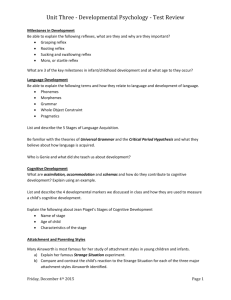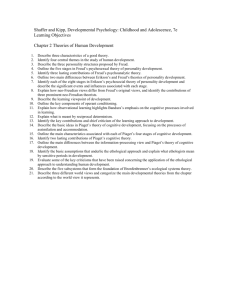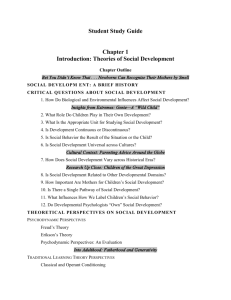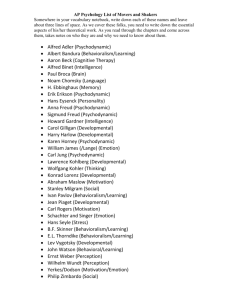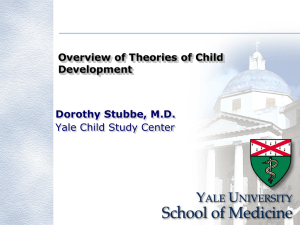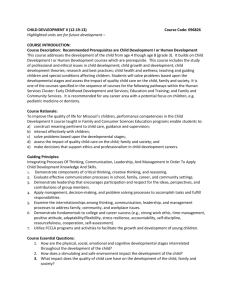Chapter 1
advertisement
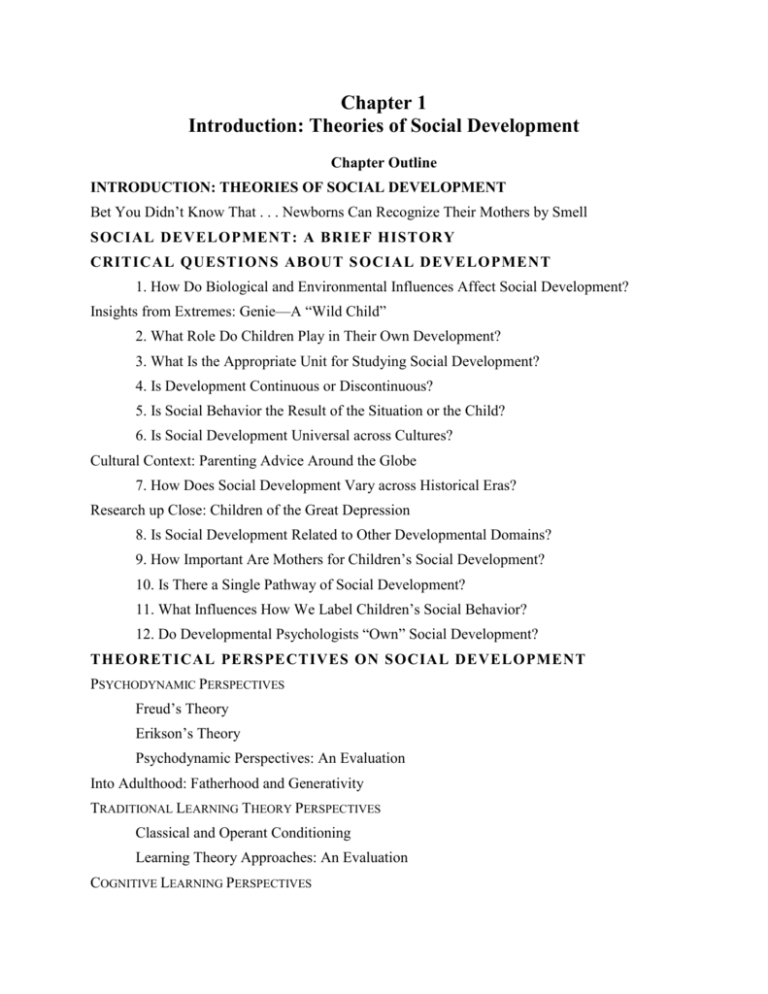
Chapter 1 Introduction: Theories of Social Development Chapter Outline INTRODUCTION: THEORIES OF SOCIAL DEVELOPMENT Bet You Didn’t Know That . . . Newborns Can Recognize Their Mothers by Smell SOCIAL DEVELOPMENT: A BRIEF HISTORY CRITICAL QUESTIONS ABOUT S OCIAL DEVELOPMENT 1. How Do Biological and Environmental Influences Affect Social Development? Insights from Extremes: Genie—A “Wild Child” 2. What Role Do Children Play in Their Own Development? 3. What Is the Appropriate Unit for Studying Social Development? 4. Is Development Continuous or Discontinuous? 5. Is Social Behavior the Result of the Situation or the Child? 6. Is Social Development Universal across Cultures? Cultural Context: Parenting Advice Around the Globe 7. How Does Social Development Vary across Historical Eras? Research up Close: Children of the Great Depression 8. Is Social Development Related to Other Developmental Domains? 9. How Important Are Mothers for Children’s Social Development? 10. Is There a Single Pathway of Social Development? 11. What Influences How We Label Children’s Social Behavior? 12. Do Developmental Psychologists “Own” Social Development? THEORETICAL PERSPECTIVES ON SOCIAL DEVELOPMENT PSYCHODYNAMIC PERSPECTIVES Freud’s Theory Erikson’s Theory Psychodynamic Perspectives: An Evaluation Into Adulthood: Fatherhood and Generativity TRADITIONAL LEARNING THEORY PERSPECTIVES Classical and Operant Conditioning Learning Theory Approaches: An Evaluation COGNITIVE LEARNING PERSPECTIVES Cognitive Social Learning Theory Beyond Modeling: Reciprocal Determination and Self-Efficacy Cognitive Social Learning Theory: An Evaluation Learning from Living Leaders: Joan E. Grusec INFORMATION-PROCESSING PERSPECTIVES Social Information Processing Information-Processing: An Evaluation COGNITIVE DEVELOPMENTAL PERSPECTIVES Piaget’s Cognitive Developmental Theory Piaget’s Theory: An Evaluation Social Cognitive Domain Perspective Vygotsky's Sociocultural Theory Vygotsky’s Theory: An Evaluation Learning from Living Leaders: Barbara Rogoff SYSTEMS THEORY PERSPECTIVES Bronfenbrenner’s Ecological Theory Ecological Systems Theory: An Evaluation BIOLOGICAL PERSPECTIVES Ethological Theory Ethological Theory: An Evaluation Evolutionary Developmental Theory Evolutionary Developmental Theory: An Evaluation Learning from Living Leaders: David Bjorklund Human Behavior Genetics Human Behavior Genetics: An Evaluation LIFE SPAN PERSPECTIVE Life Span Perspective: An Evaluation A VARIETY OF THEORETICAL PERSPECTIVES Chapter Summary Key Terms At the Movies Learning Objectives 1. Describe what the study of social development entails. 2. Summarize the historical foundations of the study of social development. 3. Understand the critical questions of social development (biological and environmental influences; role children play in their own development; appropriate unit for studying social development; continuous and discontinuous development; role of the situation vs. the child; universality of social development; variation across historical eras; social development as related to other domains; importance of mothers vs. others; single vs. multiple pathways of development; influences on judgments of children’s social behavior). 4. Understand each of the theoretical perspectives presented in this chapter. 5. Describe the strengths and weaknesses of each theoretical perspective. 6. Explain why several complimentary theories are needed for the study of social development. Student Handout 1-1 Chapter Summary Social Development The field of social development includes descriptions of social behaviors, individual differences in social behavior, and changes in social behavior with age as well as explanations for these changes and differences. Social Development: A Brief History The scientific study of social development began with Darwin’s work in the 1800s. Subsequently, competing views were expressed in Watson’s behaviorally oriented theory, Freud’s biologically inspired theory, and Gesell’s maturational theory. Critical Questions about Social Development How do biological and environmental influences affect social development? Modern developmental psychologists recognize the importance of both biological and environmental influences and are concerned with discovering the ways in which these factors interact to produce developmental differences. What role do children play in their own development? Most developmental psychologists believe that children actively shape, control, and direct the course of their own development. What is the appropriate unit for studying social development? Although researchers have typically focused on individual children, they have increasingly recognized that other units such as dyads, triads, and social groups are also important. Is development continuous or discontinuous? Some theorists view social development as a continuous process whereby change takes place smoothly and gradually. Others see development as a series of qualitatively different stages or steps. The more closely we examine development, the more we see ebbs and flows in the acquisition of social skills. Is social behavior the result of the situation or the child? Most developmental psychologists stress the complementary roles of situational factors and child differences. Is social development universal across cultures? Most developmental psychologists agree that cultural contexts should be considered but believe that universal aspects of development such as emotions, language, and communication coexist with cultural variations. How does social development vary across historical eras? Both abrupt and gradual changes in society influence social development. Is social development related to other developmental domains? Social development influences and is influenced by emotional, cognitive, language, perceptual, and motor development. How important are mothers for children’s social development? Although mothers are clearly important in children’s social development, other people including fathers, siblings, grandparents, peers, teachers, and religious leaders also are important influences. Is there a single pathway for social development? Children may start out at a similar place but end up at very different points (multifinality), or they may follow different paths but end up at the same point (equifinality). What influences how we label children’s social behavior? Three sets of factors— characteristics of the child, the adult, and the context—influence social judgments and, in turn, how social behaviors are labeled. Do developmental psychologists own social development? Scholars in a variety of fields including pediatrics, psychiatry, anthropology, economics, law, and history have made valuable contributions to the field of social development. Theoretical Perspectives on Social Development Theories help organize and integrate knowledge into a coherent account of how children develop and foster research by providing testable predictions about behavior. Historically, grand theories reflected attempts to account for all aspects of development. Modern theories tend to be more narrowly focused attempts to explain specific aspects of social development. Psychodynamic Perspective In Freud’s psychodynamic theory, basic biological drives motivate the child. Early experiences are essential for determining later behavior. Erikson expanded Freud’s theory to include social and cultural influences on development. His psychosocial theory is organized around a series of fundamental personal and social tasks that individuals must accomplish at each stage. Psychodynamic theories helped shape many concerns of modern social development, including the effects of early experience in the family and the psychological roots and importance of aggression, morality, gender roles, and attachment. However, the central claims of the theories are difficult to test empirically. Traditional Learning Perspective Traditional learning theories emphasize how new behaviors are acquired through a gradual and continuous process of learning. The theories had important applications and have been used in homes, schools, and clinics to reduce children’s behavior problems. Their lack of attention to developmental changes is a limitation. Cognitive Social Learning Theory Bandura focused attention on observational learning. The notions of reciprocal determinism and self-efficacy were important additions to this theoretical position. The lack of attention to developmental issues, the limited ecological validity of the findings, and the limited recognition of the roles of biology and culture are shortcomings of the theory. Social Information-Processing Theory This approach focuses on how children take in, use, and remember information to make decisions about social actions. The lack of developmental focus, the limited role allocated to emotion, and the heavy emphasis on deliberate decision making rather than automatic or habitual responding are limitations of this perspective. Cognitive Developmental Perspective In Piaget’s theory of development, children actively seek new experiences and from them construct mental structures. They assimilate new information into existing structures and accommodate structures when the information doesn’t fit. Piaget’s focus on stages has been questioned, and his lack of emphasis on emotions, culture, and social behavior make his theory of limited use in the field of social development. Social Cognitive Domain Theory This perspective focuses on how children learn to make social judgments about their world. According to this approach, children’s social judgments are domain specific. Vygotsky’s Sociocultural Theory This theory focuses on the contributions of social and cultural factors to children’s development. Children grow and change as a function of their own efforts and the guidance of more skilled others. The theory does not describe how interactions change over the course of development. Systems Perspective According to systems theories, other elements or members of the system influence an individual’s behaviors. Bronfenbrenner’s ecological systems theory stresses the importance of relations between the child and environmental systems, such as the family, school, community, and culture. Development involves the interplay between the child and the microsystem, mesosystem, exosystem, macrosystem, and chronosystem. Lack of developmental focus as well as limited information about the processes that govern cross-level linkages are limitations of this theory. Biological Perspective Ethologists observe behaviors in natural settings and study patterns of behaviors across human and infrahuman species and across human societies and cultures. The theory is largely descriptive. Evolutionary psychology asserts that social behaviors reflect survival needs and processes of human evolution. It focused attention on parental investment as a way to ensure intergenerational continuity of genes and on the adaptive value of immaturity. The approach has limited relevance for addressing issues associated with rapid changes. Many explanations are post hoc. Behavior genetics addresses the relative contributions of heredity and environment to social development and the interdependence between environmental conditions and whether and when genes are expressed in behavior. The particular genes or clusters of genes that account for social outcomes are still poorly understood, and the way in which the environment is measured is often very general. Life Span Theory This theory emphasizes development over the entire life course. Changes can be traced to normative age–graded events including entry into school, nonnormative events such as divorce, and historical or cohort-related events such as the Great Depression or the Vietnam War. The impact of this perspective is limited by the fact that much of the theorizing has involved older adults. Variety of Theoretical Perspectives Social development can be approached from a variety of perspectives and it is often helpful to draw on several theories to explain children’s development. Student Handout 1-2 Key Terms GLOSSARY TERMS age cohort People who were born in the same time period and share historical experiences. accommodation Modifying an existing schema to fit a new experience. assimilation Applying an existing schema to a new experience. chronosystem The time-based dimension that can alter the operation of all other systems in Bronfenbrenner’s model, from microsystem through macrosystem. classical conditioning A type of learning in which a new stimulus is repeatedly presented with a familiar stimulus until an individual learns to respond to the new stimulus in the same way as the familiar stimulus. cognitive social learning theory A theory that stresses the importance of observation and imitation in the acquisition of new behaviors, with learning mediated by cognitive processes. critical period A specific time in an organism’s development during which external factors have a unique and irreversible impact. desensitization Classical conditioning therapy used to overcome phobias and fears through exposure to increasingly intense versions of the feared stimulus. domain specificity Processes of development are different for different types of behavior, for example, moral judgments, manners, and peer relationships. drive reduction theory A version of learning theory suggesting that the association of stimulus and response in classical and operant conditioning results in learning only if it is accompanied by reduction of basic primary drives such as hunger and thirst. ecological theory A theory stressing the influences of environmental systems and the relations between the systems on development. ego In Freud’s theory, the rational component of the personality, which tries to satisfy needs through appropriate, socially acceptable behaviors. egocentric Tending to view the world from one’s own perspective and to have difficulty seeing things from another’s viewpoint. Electra complex According to Freud, girls blame their mother for their lack of a penis and focus their sexual feelings on their father. equifinality The convergence of developmental paths in which children follow very different paths to reach the same developmental end point. ethological theory A theory that behavior must be viewed in a particular context and as having adaptive or survival value. exosystem In Bronfenbrenner’s ecological theory, the collection of settings that impinge on a child’s development but in which the child does not play a direct role. generativity A concern for people besides oneself, especially a desire to nurture and guide younger people and contribute to the next generation. id In Freud’s theory, instinctual drives that operate on the basis of the pleasure principle. macrosystem In Bronfenbrenner’s ecological theory, the system that surrounds the microsystem, mesosystem, and exosystem, representing the values, ideologies, and laws of the society or culture. maturation A biologically determined process of growth that unfolds over a period of time. mesosystem In Bronfenbrenner’s ecological theory, the interrelation among the components of the microsystem. microsystem In Bronfenbrenner’s ecological theory, the context in which children live and interact with the people and institutions closest to them, such as parents, peers, and school. multifinality The divergence of developmental paths in which two individuals start out similarly but end at very different points. object permanence The realization in infancy that objects and people do not cease to exist when they are no longer visible. Oedipus complex Freud’s theory that boys become attracted to their mother and jealous of their father. operant conditioning A type of learning that depends on the consequence of the behavior; rewards increase the likelihood that a behavior will recur, but punishment decreases that likelihood. psychodynamic theory Freud’s theory that development is determined by innate biologically based drives shaped by encounters with the environment in early childhood. psychosocial theory Erikson’s theory that each stage of development depends on accomplishing a psychological task in interactions with the social environment. social dyad A pair of social partners, such as friends, parent and child, or marital partners. social information-processing theory An explanation of a person’s social behavior in terms of his or her assessment and evaluation of the social situation as a guide deciding on a course of social action. sociocultural theory Vygotsky’s theory that development emerges from interactions with more skilled people and the institutions and tools provided by the culture. superego In Freud’s theory, the personality component that is the repository of the child’s internalization of parental or societal values, morals, and roles. systems Developmental contexts made up of interacting parts or components, for example, a family. transactional Ongoing interchanges between social partners such as a parent and child across time that result in modifications of the social behavior of each. zone of proximal development The difference between children’s level of performance while working alone and while working with more experienced partners. OTHER IMPORTANT TERMS IN THIS CHAPTER collective efficacy continuity discontinuity diverse disciplinary perspectives domains of development historical events non-normative events normative events person factors reciprocal determinism self-efficacy sensitive period situation factors social judgments species specific unit of analysis Student Handout 1-3 Theorist/Theoretical Question 1: Question 4: Question 5: Question 6: Perspective Biology (B) Continuity (C) Situation (S) Universal (U) versus versus versus versus Environment (E) Discontinuity (D) Individual (I) Cultural (C) Freud Erikson Learning Cognitive social learning Information processing Piaget Vygotsky Ecological Ethological Evolutionary Behavior genetics Life span Practice Exam Questions MULTIPLE CHOICE QUESTIONS 1. People who are born within the same time period and share historical experiences are called: (a) a population (b) *an age cohort (c) a normative event cohort (d) a social dyad 2. Liz has learned how to print her name with both a crayon and a pencil. Which of the following illustrates assimilation? (a) *Her mother gives her an ink pen and Liz immediately begins to print her name (b) Her mother gives her an ink pen and Liz ignores it, keeping the pencil instead (c) Her mother gives her a brush and paint and Liz learns to place the brush into the paint before trying to print her name (d) none of the above 3. Which of the following is not emphasized by cognitive social learning theory? (a) *reinforcement of observed behavior (b) observation and imitation of behavior (c) motivation to reproduce or imitate behavior (d) attention and retention of observed behaviors 4. A theory that stresses the importance of the relations between organisms and environmental systems and the relations between the systems themselves is: (a) sociocultural theory (b) *ecological theory (c) ethological theory (d) evolutionary developmental theory 5. The fact that children follow very different paths to reach the same developmental end point is referred to as: (a) multifinality (b) *equifinality (c) domain specificity (d) age cohorts 6. Generativity is a goal included in: (a) Freud’s psychodynamic theory (b) Bronfenbrenner’s ecological theory (c) Bandura’s cognitive social learning theory (d) *Erikson’s psychosocial theory 7. In Bronfenbrenner’s ecological theory, the context in which children live and interact with the people and institutions closest to them, such as parents, peers, and school, is the: (a) macrosystem (b) mesosystem (c) *microsystem (d) exosystem 8. The concept of object permanence was first identified by: (a) Vygotsky (b) *Piaget (c) Freud (d) Erikson 9. Which of the following best illustrates operant conditioning: (a) a parent tells a child he did a good job after he completes his homework early (b) a parent will not allow a child to watch TV because she broke a house rule (c) a parent makes sure to reward a child’s prosocial behavior at least some of the time (d) *all of the above 10. The zone of proximal development refers to: (a) *the difference between a child’s level of performance while working alone and while working with a more experienced partner (b) the difference between a child’s performance while working with an equally experienced partner and while working with a more experienced partner (c) the difference in performance between a child working with an experienced partner and another child working alone (d) the difference in performance between a child working with a age-appropriate task and a task that is intended for children at other ages ESSAY QUESTIONS 1. List the levels of analysis in Bronfenbrenner’s theory and give an example of each. 2. Discuss the role that cognitive development plays in social development. 3. Unidirectional models in which adults are the main drivers of children’s social development are no longer adequate. Why not and what models have replaced them?

